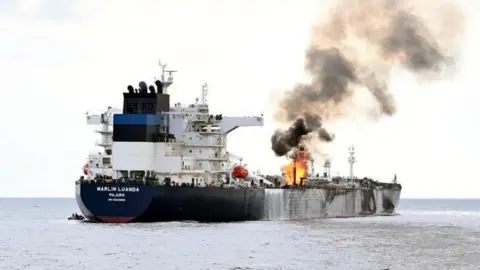The world is once again on the edge of a geopolitical oil crisis, and the flashpoint is a narrow but vitally important body of water: the strait of Hormuz. As tensions between Iran, Israel, and America escalate into the possibility of open conflict, global energy markets are bracing for the worst. For countries like Kenya, which relies heavily on imports of heavy fuel oil (HFO), the impact could be significant. A blockage or disruption in the strait of Hormuz could send shockwaves through shipping lanes, oil prices, and supply chains, threatening power generation, transport, and industrial operations in East Africa and beyond.
Understanding the Strait of Hormuz and Its Significance to Iran
The strait of Hormuz is a strategic chokepoint connecting the Persian Gulf with the Gulf of Oman and the Arabian Sea. It lies between Iran to the north and the United Arab Emirates and Oman to the south. This 21-mile-wide stretch of water is one of the world’s most critical oil transit routes. According to the U.S. Energy Information Administration, nearly 20% of global oil and almost one-third of the world’s liquefied natural gas pass through the strait of Hormuz every day.
Why is this narrow waterway so crucial? Because it’s the only sea passage from the oil-rich Persian Gulf to the open ocean. Major oil producers like Saudi Arabia, Iraq, the UAE, Kuwait, and Iran export the bulk of their crude and heavy fuel oil (HFO) through this route. Any disruption whether through military action, sabotage, or political brinkmanship immediately triggers fears of supply shortages, skyrocketing prices, and economic instability worldwide.
The Current Conflict: Iran, Israel, and America on the Brink
The Middle East has long been a region of fragile balances, but the latest escalation between Iran and Israel with the involvement of the United States has brought the situation to a boiling point. Following a series of retaliatory strikes, covert operations, and naval confrontations, the region now teeters on the edge of full-scale war. Iran has repeatedly warned that it would consider closing the strait of Hormuz if it faces an existential threat or direct military intervention.
With the U.S. backing Israel both diplomatically and militarily, and Iran leveraging its influence over key shipping routes and regional proxies, the situation presents a dire risk to maritime stability in the Gulf. Iranian Revolutionary Guard naval forces have previously seized oil tankers and threatened vessels navigating the strait of Hormuz, signaling that the threat is not just rhetorical.
Iran, the Houthis, and Targeted Attacks on Oil Supply Ships
A crucial but often overlooked aspect of this unfolding crisis is Iran’s deepening ties with the Houthi rebels in Yemen. As part of Iran’s broader regional strategy to exert influence and challenge Western-aligned powers, the Houthis have emerged as a significant proxy group capable of disrupting shipping in the Red Sea and Arabian Sea.
In recent months, Houthi militants believed to be acting with Iranian logistical and intelligence support have launched multiple drone and missile attacks on commercial shipping vessels, including oil tankers and supply ships bound for ports in East Africa and Asia. One recent attack disabled a Liberian-flagged ship carrying heavy fuel oil through the Gulf of Aden, a critical route for tankers avoiding the strait of Hormuz due to tensions.

These attacks have two major implications:
- They expand the threat zone beyond the strait of Hormuz, making even alternative shipping lanes vulnerable to disruption.
- They serve as a reminder of how asymmetric warfare—using inexpensive drones or small boats can have an outsized effect on global oil logistics.
For Kenya, this represents a dual threat. Not only is the HFO supply from the Gulf at risk due to possible closure of the strait of Hormuz, but even rerouted vessels through the Red Sea are now exposed to attack or delays.
The Global Oil Industry Feels the Heat
As tension mounts, the oil markets have already responded. Brent crude prices have jumped, and insurance premiums for vessels traveling through the strait of Hormuz have surged. Shipping companies are rerouting, delaying, or cancelling voyages altogether.
Most critically, the supply of heavy fuel oil (HFO), a residual product of crude oil refining used in power plants, shipping, and industrial boiler is facing disruptions. Producers in the Gulf such as Iran, Iraq, and the UAE are major exporters of HFO, and with tankers unable or unwilling to navigate the strait, supply bottlenecks are inevitable.
Impact on Kenya: Heavy Fuel Oil Supply Under Threat
Kenya is particularly vulnerable in this scenario. While it has diversified its energy mix with hydropower, geothermal, and wind, a significant portion of its industrial and backup power generation still relies on heavy fuel oil. Major power plants such as Kipevu III in Mombasa and other independent power producers (IPPs) use HFO as a primary or supplementary fuel source.
Kenya does not produce HFO locally in commercial quantities and depends on imports from the Middle East. A closure or blockade of the strait of Hormuz would severely restrict access to this crucial fuel. This could result in:
- Power shortages or increased costs of electricity due to expensive alternative fuels.
- Inflationary pressure from higher transport and manufacturing costs.
- Disruptions in maritime logistics affecting Mombasa port operations and related industries.
- A shift in procurement strategies, forcing importers to seek more expensive, less reliable sources from outside the Gulf region.
Already, Kenyan fuel marketers and power producers are monitoring the situation with concern. A prolonged disruption could necessitate emergency government intervention, potentially even tapping strategic reserves or exploring fuel rationing.
What Happens If the Strait of Hormuz is Blocked?
A full-scale closure of the strait of Hormuz would be catastrophic. Not only would Iran choke off a fifth of global oil supply, but tankers carrying heavy fuel oil and other refined products to countries like Kenya would be unable to leave the Gulf.
Alternate routes like the East-West Pipeline in Saudi Arabia or the SUMED pipeline in Egypt can only partially compensate and are limited in volume and accessibility. Additionally, rerouting tankers around the Cape of Good Hope is not viable for HFO imports to Kenya due to the added time and cost.
In such a scenario:
- Oil prices could soar above $150 per barrel.
- HFO spot prices could spike disproportionately due to its limited production base and storage capacity.
- Supply contracts may be suspended or renegotiated at much higher rates.
- Kenya’s power grid could come under immense pressure if HFO-fired plants run low on fuel.
- Industries dependent on steam boilers and heavy-duty engines may be forced to shut down or scale back operations.
Geopolitical Responses and Strategic Calculations
The international community, particularly oil-importing nations like China, India, and the EU, are unlikely to stay neutral if the strait of Hormuz is effectively blocked. Naval coalitions could be formed to secure shipping lanes, while diplomatic pressure would mount on Iran to reopen access.
However, Iran is well aware of the leverage the strait gives it. As long as tensions with Israel and the U.S. remain high, Tehran could use the threat of disruption as a bargaining chip.
Kenya, as part of the global oil market and a non-aligned country in this conflict, will need to make strategic decisions. These may include:
- Strengthening bilateral ties with alternative fuel suppliers outside the Gulf.
- Accelerating investment in renewable energy and energy storage to reduce dependency on HFO.
- Lobbying for regional oil infrastructure projects to be fast-tracked, such as the Kenya-Uganda-Tanzania oil pipeline network.
Is There a Way Out?
The situation is volatile, but not without hope. De-escalation through diplomacy, renewed nuclear negotiations with Iran, or backchannel talks between Washington and Tehran could defuse tensions. The U.S. Navy’s presence in the Gulf acts as a deterrent against a full-scale blockade, though the risk of miscalculation remains high.
For now, global oil markets and countries like Kenya must brace for continued uncertainty. The future of heavy fuel oil supply, energy stability, and economic resilience hinges not just on local policies, but on what happens 3,000 miles away in the waters of the strait of Hormuz.
Conclusion: Preparing for an Uncertain Energy Future
The emerging crisis in the Middle East underscores the fragility of the global energy supply chain. The strait of Hormuz is not just a regional chokepoint; it is the aorta of the world’s oil economy. When global powers like Iran, Israel, and America are at odds, the consequences ripple far and wide.
For Kenya, the threat is not theoretical. It’s a looming reality that could affect power generation, transport, and industrial output. The disruption of heavy fuel oil supply from the Gulf is a national concern that calls for strategic planning, investment in diversification, and regional cooperation.
As the world watches the unfolding drama in the Persian Gulf, one truth remains clear: the stability of the strait of Hormuz is not just a geopolitical issue, it is a global lifeline, and its disruption could redefine energy security for a generation.

